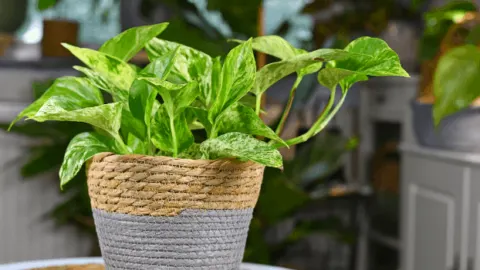You are reading this article to learn more about Marble Queen Pothos and its care.
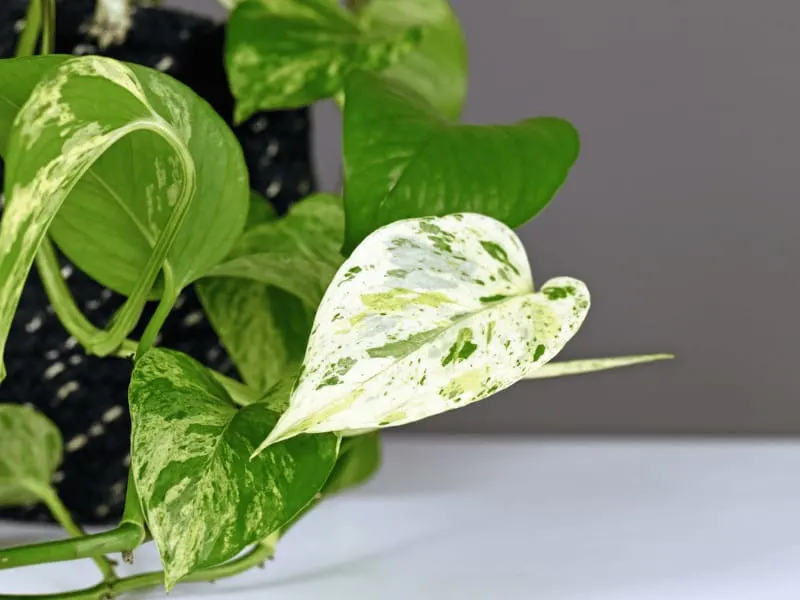
Marble Queen Pothos
The scientific name for Marble Queen Pothos is Epipremnum aureum ‘Marble Queen’.
It is native to French Polynesia.
Marble Queen Pothos is now a very common ornamental plant in tropical and temperate regions, widely grown for its creamy white and green variegated foliage, according to the University of Florida.
Epipremnum aureum is popularly known as Devil’s Ivy or Money Plant. Let’s just stick with Marble Pothos. People grow Marble Pothos indoors for its air-purifying properties, but strangely enough, it is toxic and non-ingestible for pets and humans.
Juvenile leaves are heart-shaped, but mature leaves of a large plant are typically pinnated. The list of interesting contradictions keeps me fascinated.
Takeaways
| Species | Epipremnum aureum 'Marble Queen' |
| Synonyms | Marble Queen Pothos |
| Family | Araceae |
| Genus | Pothos |
| Growth | Upright, hanging |
| Height | 40 feet |
| Width | 6 feet |
| Soil | Well-draining |
| Watering | Every 7-14 days |
| Light | Bright indirect |
| Temperature | Min: 65.0°F, Max: 90.0°F (Min: 18.3°C, Max: 32.2°C) |
| Humidity | Min: 40.0%, Max: 60.0% |
| Fertilizer | One a monh |
| Propagation | Stem cuttings |
| Toxicity | Toxic to humans, cats, and dogs. |
Table of Contents
Marble Queen Pothos Care
A Marble Queen Pothos grows best in well-draining soil. Provide bright indirect sunlight. Avoid direct sun. Water every 7-14 days and keep the soil slightly dry.
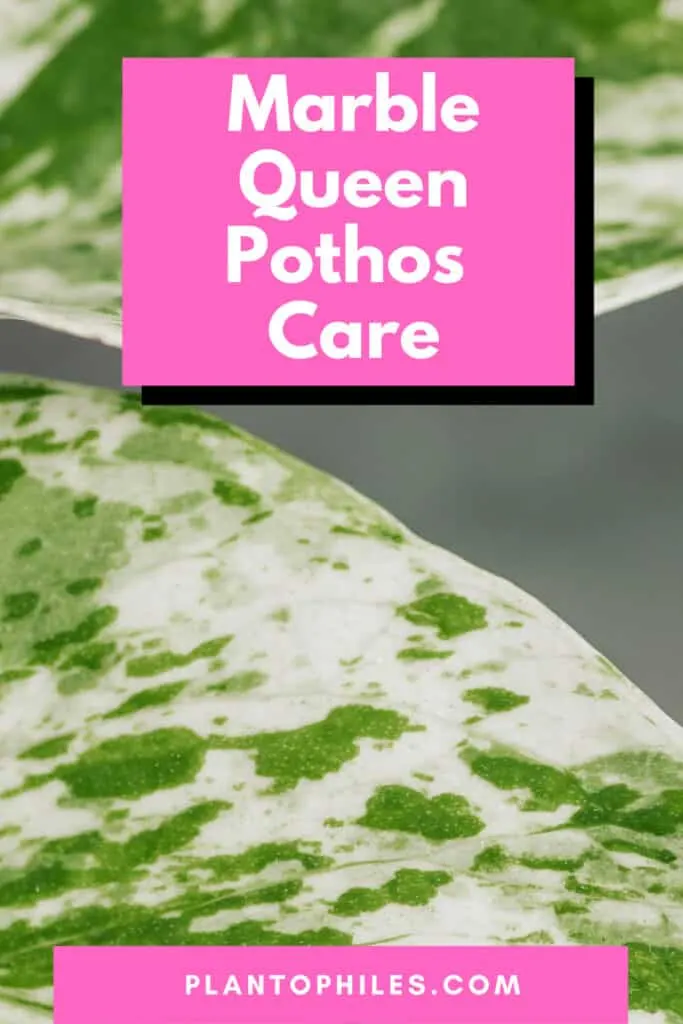
Soil
The Marble Pothos grows best in well-draining soil. You can use a mix of peat miss, perlite, coconut husk, or orchid bark, as well as some potting soil.
Suppose you don’t think your soil is quick-draining enough, add a little sand to the mix, and that should do. They will thrive in nutrient-rich soil as any plant would but do equally well in average soil.
You can also grow Marble Pothos in plain water. Exchange the water weekly and add liquid fertilizer every 2-4 weeks. This way, Pothos can grow in water indefinitely.
This ensures your Epipremnum aureum ‘Marble Queen’ gets a fresh supply of nutrients from the water plus the water doesn’t get murky with algae build-up (which happens as a result of exposure to sunlight).
Before placing your plant in water, carefully prune out any roots that appear to be rotting. Put a drop of hydrogen peroxide to oxygenate the water to prevent the risk of fungal infection.
Use liquid fertilizer in a very diluted form (diluted at half strength is usually a good way to go about it) once a month.

Light
Epipremnum aureum grows best in bright indirect light.
Remember that you get better results with the variegation if you grow Marble Pothos in brighter light. They don’t do well in direct sunlight as the sun burns the foliage.
Low light tolerance makes them suitable as ornamentals in offices and low-lit rooms like a bathroom. Just keep an eye out for the variegation.
Only the green parts of the leaves can make energy for the plant, so in low light, the leaves will compensate for the lack of light by turning green.
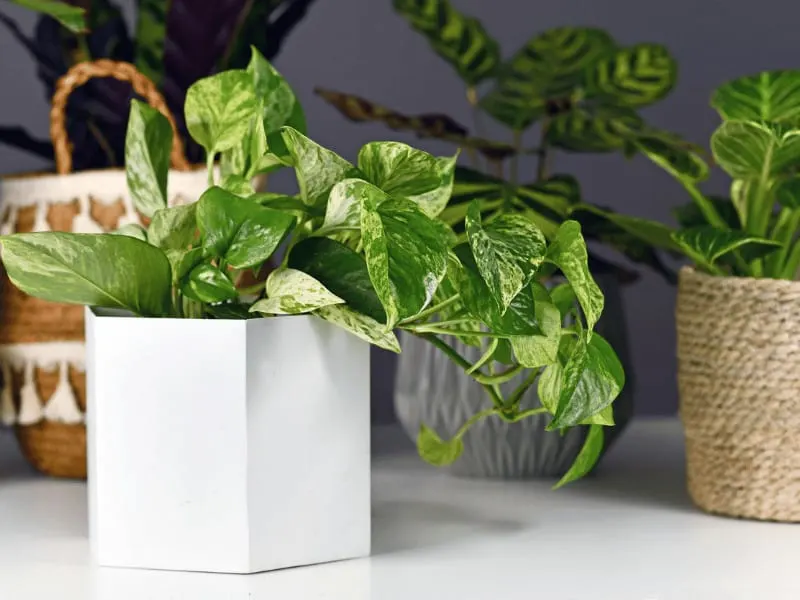
Watering
Water a Photos Marble Queen every 7-14 days. Keep the soil on the dry side. That makes them somewhat neglect tolerant and not too keen on over-pampering.
I would recommend that you do a drench and dry cycle, i.e., I let the soil mix dry out almost 50% between waterings. Drench it completely when you water.
Particularly during the growing months, i.e., spring and summer, this method of drenching and dry watering boosts plant growth. In the fall and winter, I let the soil stay dry for longer before watering and rely on misting.
Keep a close eye on the leaves. If you notice the edges getting brown and dry, then you’re underwatering.
If the leaves turn yellow and the soil feels soggy, it could be a sign of overwatering.
Temperature
It is best to grow Marble Pothos in warm temperatures between 65-90°F (18-32 degrees Celsius). It survives the winters without a fuss if it is indoors at room temperature. Pothos is not frost-hardy.
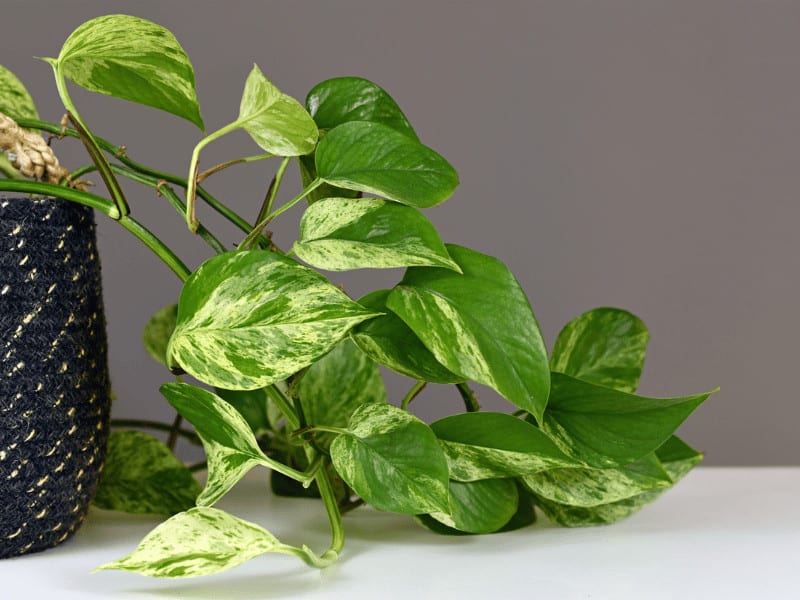
Humidity
Keep the Marble Queen at a humidity between 40-60%.
Like all tropical plants, a humid environment is good for growing Marble Pothos.
They love being misted, and it helps them stay fresh and clean. You can even give the leathery leaves a sponge bath if you like.
When you grow Marble Pothos indoors during colder months watch out for brown leaf tips which indicate air dryness.
Marble Queen Pothos Fertilizer
For the Marble Pothos use a well-balanced general-purpose indoor plant fertilizer once a month. Organic is the safest. Fertilize from spring to autumn.
If you want to go a bit more “pro” with your Marble Pothos care, you may use compost or liquid seaweed solution for fertilizing the soil at least once a month.
This boosts foliage growth and make the plant look bushier.
Make sure you thin down the concentration of the fertilizer to half the prescribed level just to be on the safe side. Under-fertilizing is better than over-fertilizing.
Remember that you fertilize mostly in the growing months and cut back in winter.
Marble Queen Pothos Propagation
Marble Queen Pothos are some of the easiest plants to propagate. They grow readily from stem cuttings and through layering.
Back when I was in school, we had pruned our ground trailing Marble Pothos and thrown away the terminals into the mulching pit in the backyard.
A week later all the terminals had sprouted roots and sprung upright. It’s about that simple. Read on, for a step-by-step guide on how to propagate and grow Marble Pothos.
Pothos Growing Methods
For compact growth, mainly used in interior decoration, you can use a hanging basket for your Pothos. Alternatively, use a small pot for the table or a glass/ceramic for the window sides. If you have a garden or a greenhouse you can let it climb a totem or trellis.
If you grow Marble Pothos on a trellis, remember that it is a fairly virulent grower and easily chokes up all the available space constraining other plants nearby. If you live closer to the equator you can let it climb on a mature tree and watch the beautiful gigantic leaves fan out at the top.
I am often reminded of the bean stalk in ‘Jack in the Bean Stalk’ because, quite honestly, you can grow Marble Pothos right up to the clouds! Oftentimes, the giant pothos vine becomes the main distinguishing feature of the house it is growing in.
Pruning
Marble Pothos care requires regular pruning to prevent the vines from getting leggy. Trim out any discoloured leaves and stems with a sharp garden scissors for a clean look.
One tip to grow Marble Pothos nice and bushy is to aggressively trim the long vines just before the growing season and to use the stem cuttings to start new plants in the same pot.
You can also twirl back long vines into the pot through layering.
Potting
For larger Pothos plants repotting is required every 2-3 years. Repotting is best done in spring.
Pruning
Marble Pothos care requires regular trimming and pruning and at least an annual repotting cycle particularly for plants grown in small pots. The roots grow fairly fast and consume all the soil.
You will see them creeping out of the drainage holes. Once they fill the existing pot, remove the plant along with the root ball and move it to a larger pot.
You may need to cut out some roots and loosen the outer side of the root ball before repotting.
How to Propagate Marble Queen Pothos – Step by Step
Propagate Marble Queen Pothos from Cuttings (in Soil)
1. Choose a strong healthy vine from the Marble Pothos mother plant noting the soil end of the vine
2. Cut the stem with four nodes and a terminal using a pair of sharp garden scissors
3. Ideally, you should choose a strong thick vine that hasn’t grown very long to cut close to the soil. The nodes near the soil take root reliably. It would be even better to see aerial roots on the nodes of the Marble Pothos cutting at the soil end.
4. Pinch the leaves at the bottom to expose the nodes leaving only the leaves at the terminal.
5. Use the pot of the mother plant. The soil needs to be loosened at least 5 inches deep.
6. If you’re using a fresh pot, I recommend using a medium size pot and planting several cuttings together, like, say, 3 – 5 cuttings. This will result in a bushy pot. Pro tip: don’t plant the cutting wide apart. Plant them as one single bunch right at the center of the pot.
7. The soil needs to be well-draining because Marble Pothos cuttings are prone to rotting before rooting.
8. You don’t need a rooting hormone for Marble Pothos cuttings because they typically root quite readily.
9. Stick in the stem(s) with at least one node well under the soil and press down the soil for support.
10. Keep the pot in a fairly bright spot but away from direct sun.
11. Water well and moisten the soil until the cutting is established. This should take 1 – 2 weeks.
12. You’ll know they are set when the terminal leaves perk up.
Propagate Marble Queen Pothos in water
1. Follow the instructions up to step 4 in the above section
2. Select a jar that has a mouth that is at least 3 inches wide and only deep enough that the bottom two nodes of the cutting are underwater but the terminal leaves are out. Taller jam jars work well.
3. Pro tip: If the mouth of the jar is too narrow, the roots break while pulling the cutting out.
4. Put your cutting in the jar filled with clean water.
5. If the cutting isn’t sitting well in the jar, I use cling foil to cover the mouth of the jar leaving just enough gap to let the cutting through. This should help hold the cutting in place.
6. Keep the jar in a spot with indirect sunlight and don’t move it around too much.
7. New roots will sprout from the nodes submerged in water after 1 – 2 weeks.
8. You can transfer the cutting to the soil once the roots are an inch or two long or let it grow in water.
9. If you grow Marble Pothos in water, pick a good quality balanced liquid fertilizer to feed your plant. Fertilize your plant once every month. Check for instructions in the “How to fertilize your Marble Queen Pothos” section.
Use Air Layering for your Marble P.
1. Choose a strong healthy stem on a mature, well-established Marble Pothos plant.
2. Make sure it’s a long stem over a foot long with 4 to 5 leaf nodes.
3. Pinch off alternate leaves to expose the nodes but keep the terminal leaves.
4. Loosen 5 inches on the soil around the mother plant
5. Twirl the prepared stem back into the soil
6. Now carefully pin down the exposed nodes in the loosened soil using hair pins to secure them.
7. Cover these nodes with soil and water.
8. Continue with Marble Pothos care as usual
9. The nodes should catch roots within two weeks.
10. Pro tip: DON’T constantly check for roots. Your chances of success increase if you forget about it for a few weeks.
Read on for detailed Marble Pothos propagation steps.
Marble Queen Pothos Size
At heights, the leaves of a Marble Queen Pothos get as big as 3 ft long (0.9 meters), fanning out like large elephant ears. In colder climates, home gardeners grow Marble Pothos in hanging baskets or simply as an indoor potted plant trained on a peat moss pole.
Marble Pothos in a hanging basket it’s a dangly vine, but with support, it grows tall, strong, and erect. It is a small plant of about 2 ft (0.6 meters) when grown in a pot but could grow 20ft tall (6 meters) when it crawls up a wall.
Let’s now dive right into the general Marble Pothos care guide. I’ll give you some handy tips on growing Marble Pothos successfully.
Common Problems with Marble Queen Pothos
Marble Pothos are relatively pest-free.
Aphids, thrips, and mealybugs may be problematic and can be treated with neem oil or organic insecticidal soap. Regularly washing the leaves with a water jet helps keep the plant pest-free.
Marble Pothos Leaves turningGreen
The plant is not getting enough light to maintain the white variegation in its leaves. Marble Pothos care requires a brighter location for the leaves to remain white and green.
Dark Patches on the Leaves
The temperature may be too low for a Marble Pothos especially at night. Cut away the damaged leaves and move your plant to a warmer location.
Droopy leaves
This typically happens due to a root rot caused due to over watering the plant. Check the base of the plant immediately.
I would salvage a few cuttings and try to propagate them separately in a fresh pot using sterile well-draining soil.
Yellow Leaves / Brown Leaves on a Marble Queen Pothos
If you notice the edges getting brown and dry, you’re underwatering. If the leaves turn yellow and the soil feels soggy it could be a sign of overwatering.
Stems are too leggy
If left un-pruned, the vines get too long and leggy. You can get bushy growth through aggressive pruning once a year before the growing season.
Pothos Varieties
There are many different Pothos varieties available. Here is a list of some of my favorites:
- Golden Pothos (Epipremnum aureum)
- Marble Queen Pothos (Epipremnum aureum ‘Marble Queen’)
- Cebu Blue Pothos (Epipremum pinnatum)
- Njoy Pothos (Epipremum pinnatum ‘NJoy’)
- Hawaiian Pothos (Epipremnum aureum ‘Hawaiian’)
- Manjula Pothos (Epipremnum aureum ‘Manjula’)
- Jade Pothos (Epipremnum aureum ‘Jade’)
- Neon Pothos (Epipremnum aureum ‘Neon’)
- Silver Pothos (Scindapsus pictus ‘Silver’)
- Snow Queen Pothos (Epipremnum aureum ‘Snow Queen’)
FAQ
Does pothos grow faster in water or soil?
In my experience, growing Marble Pothos in water slows it down even when fertilized. I haven’t seen a bushy growth out of a bottle-grown plant, although it is technically suitable for hydroponic growing. So for all practical reasons, I’d recommend soil if you want to grow Marble Pothos big and fast.
Can Marble Pothos live in the water forever?
Technically yes, although the water needs to be regularly replenished with the nutrients needed for proper Marble Pothos care.
Is Marble Queen Pothos toxic to cats?
ASPCA reports that Pothos is toxic to dogs and cats. This plant contains insoluble calcium oxalate crystals similar to other plants in the Araceae family. Chewing or biting into this plant will release these crystals, causing tissue penetration and irritation of the mouth and GI tract. Pets that consume any part of the plant may exhibit vomiting, pawing at the mouth, lack of appetite, and drooling.
Does Marble Queen Pothos purify the air?
People grow Marble Pothos for their air-purifying properties. These plants help in removing common household toxins from the air, making them a healthy and beautiful addition to your space. The NASA studies on indoor pollution in 1989 recommends 15 to 18 plants in 6 to 8-inch-diameter (15-20 cm) containers to clean the air in an average 1,800 square-foot house.
Conclusion
Marble Queen Pothos is easy to care for and I hope my guide is helpful!

Daniel has been a plant enthusiast for over 20 years. He owns hundreds of houseplants and prepares for the chili growing seasons yearly with great anticipation. His favorite plants are plant species in the Araceae family, such as Monstera, Philodendron, and Anthurium. He also loves gardening and is growing hot peppers, tomatoes, and many more vegetables.

